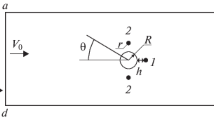Abstract
We analysed the modifications of the near wake of a circular cylinder (2,300< Re <58,000) when the flow was perturbed steadily using an electrohydrodynamic actuator. Two electrodes flush-mounted on the surface of the cylinder were excited with DC power supplies to create a plasma sheet contouring the body. The discharge produced an electric force and changed the physical properties in the fluid layers at close vicinity to the surface. This plasma sheet diminished the base pressure, modified the size of the mean recirculation region and produced an increase in the shear stresses of the layers bounding the contour of this region.










Similar content being viewed by others
References
Artana G, Desimone G, Touchard G (1999) Study of the changes in the flow around a cylinder caused by electroconvection. In: Electrostatics’99, Philadelphia, pp 147–152
Artana G, D’Adamo J, Desimone G, DiPrimio G (2000) Air flow control with electrohydrodynamic actuators. In: Proc 2nd int workshop on conduction convection and brakdown in fluids, Grenoble, pp 190–194
Artana G, Diprimio G, Moreau E, Touchard G (2001) Electrohydrodynamic actuators on a subsonic air flow around a circular cylinder. AIAA paper 2001-3056
Artana G, D’Adamo J, Leger L, Moreau E, Touchard G (2002) Flow control with electrohydrodynamic actuators. AIAA J 9:1773–1779
Bloor MS (1963) The transition to turbulence in the wake of a circular cylinder. J Fluid Mech 19:290–304
Bushnell D (1983) Turbulent drag reduction for external flows. AIAA paper 83-0227
Chyu C, Lin C, Sheridan J, Rockwell D (1995) Karman vortex formation from a cylinder: role of phase-locked Kelvin–Helmholtz vortices. Phys Fluids 7:2288–2290
Colver G, El-Khabiry S (1999) Modeling of DC corona discharge along an electrically conductive flat plate with gas flow. IEEE Trans Ind Appl 35:387–394
Corke T, Mattalis E (2000) Phased plasma arrays for unsteady flow control. AIAA paper 2000-2323
Corke T, Jumper E, Post M, Orlov D, McLaughlin T (2002) Applications weakly ionized plasmas as wing flow control devices. AIAA paper 2002-0350
Desimone G (2000) Estudio experimental de la modificación del escurrimiento alrededor de un cilindro circular a través de la electroconvección. Dissertation, Facultad de Ingeniería, Universidad de Buenos Aires, Argentina
Desimone G, DiPrimio G, Artana G (1999) Modification of the flow around a cylinder by means of electrodes placed on its surface. In: Proc colloque de la societé Francaise d’electrostatique, Poitiers, pp 80–84
El-Khabiry S, Colver G (1997) Drag reduction by D.C. corona discharge along an electrically conductive flat plate for small Reynolds number flows. Phys Fluids 9:587–599
Huerre P, Monkewitz P (1990) Local and global instabilities in spatially developing flows. Annu Rev Fluid Mech 22:473–537
Hultgren LS, Ashpis DE (2003) Demonstration of separation delay with glow-discharge plasma actuators. AIAA paper 2003-1025
Johnson J, Scott S (2001) Plasma–aerodynamic boundary layer interaction studies. AIAA paper 2001-30523
Keane R, Adrian R (1992) Theory of cross correlation analysis of PIV images. Appl Sci Res 49:191–215
Léger L, Moreau E, Touchard G (2002a) Effect of a DC corona electrical discharge on the airflow along a flat plate. IEEE Trans Ind Appl 38:1478–1485
Léger L, Moreau E, Touchard G (2002b) Electrohydrodynamic airflow control along a flat plate by a DC surface corona discharge—velocity profile and wall pressure measurements. AIAA paper 2002-2833
Léger L, Moreau E, Artana G, Touchard G (2000) Modification de l’ecoulement d’air autour d’une plaque plane par une decharge couronne. Colloque de la Societe Francaise d’Eectrostatique, Montpellier, pp 97–101
Léger L, Moreau E, Artana G, Touchard G (2001) Influence of a DC corona discharge on the airflow along an inclined flat plate. J Electrostat 50/51:300–306
Lorber P, McCormick D, Pollack M, Breuer K, Corke T, Anderson I (2000) Rotorcraft retreating blade stall control. AIAA paper 2000-2475
Malik M, Weinstein L, Hussaini M (1983) Ion wind drag reduction. AIAA paper 83-0231
Meier GEA (1996) Active control of boundary layer and separation. In: Meier GEA, Schnerr GH (eds) Control of flow instabilities and unsteady flows. Springer-Wien, New York, pp 203–233
Norberg C (1994) An experimental investigation of the flow around a circular cylinder: influence of aspect radio. J Fluid Mech 258:287–316
Roshko A (1993) Perspectives on bluff body aerodynamics. J Wind Ind Aerodyn 49:78–79
Roth JR, Sherman D (1998) Boundary layer flow control with a one atmosphere uniform glow discharge surface plasma. AIAA paper 98-0328
Roth JR, Sherman D (2000) Electrohydrodynamic flow control with a glow discharge surface plasma. AIAA J 38:1166–1178
Scherbakov Y, et al (2000) Drag reduction by AC streamer corona discharges along a wing-like profile plate. AIAA paper 2000-2670
Soetomo F (1992) The influence of high voltage discharge on flat plate drag at low Reynolds number air flow. Dissertation, Iowa State University, Ames, IA, USA
Sychev V (1982) Asymptotic theory of separated flows. Mekh Zhidkosti i Gaza 2:20–30
Tensi J, Boué I, Paillé F, Dury G (2002) Modification of the wake behind a circular cylinder by using synthetic jets. J Visualiz 5:37–44
Unal MF, Rockwell D (1988) On vortex formation from a cylinder. 1. The initial instability. J Fluid Mech 190:491–512
Wilkinson SP (2003) Investigation of an oscillating surface plasma for turbulent drag reduction. AIAA paper 2003-1023
Williamson CHK (1996) Vortex dynamics in the cylinder wake. Annu Rev Fluid Mech 28:477–539
Zdravkovich M (1997) In: Flow around circular cylinders, vol 1. Oxford Science, Oxford, pp 1–18
Acknowledgements
This research was supported by the UBACYT AI-03 and PICT 2000–2001 12-482 grants from the Argentine government.
Author information
Authors and Affiliations
Corresponding author
Rights and permissions
About this article
Cite this article
Artana, G., Sosa, R., Moreau, E. et al. Control of the near-wake flow around a circular cylinder with electrohydrodynamic actuators. Exp Fluids 35, 580–588 (2003). https://doi.org/10.1007/s00348-003-0704-z
Received:
Accepted:
Published:
Issue Date:
DOI: https://doi.org/10.1007/s00348-003-0704-z




